Wikipedia:Picture of the day/September 2023
|
Featured picture tools: |
These featured pictures, as scheduled below, appeared as the picture of the day (POTD) on the English Wikipedia's Main Page in September 2023. Individual sections for each day on this page can be linked to with the day number as the anchor name (e.g. [[Wikipedia:Picture of the day/September 2023#1]] for September 1).
You can add an automatically updating POTD template to your user page using {{Pic of the day}} (version with blurb) or {{POTD}} (version without blurb). For instructions on how to make custom POTD layouts, see Wikipedia:Picture of the day.Purge server cache
September 1
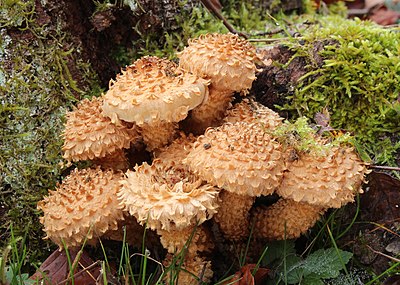
|
Pholiota squarrosa is a species of mushroom in the family Strophariaceae. Common in North America and Europe, it is a secondary parasite, in that it attacks trees that have already been weakened from prior injury or infection by bacteria or other fungi. It has a wide range of hosts among deciduous trees, although it can also infect conifers. It can also live as a saprobe, deriving nutrients from decomposing wood. The mushroom is typically found growing in clusters at the base of trees and stumps, and is covered in small, pointed scales that are pointed downward and backward. This P. squarrosa cluster was photographed near Ingstetten in Schelklingen, Germany. Photograph credit: Holger Krisp
Recently featured:
|
September 2

|
Jasmund National Park is a nature reserve on the Jasmund peninsula, in the northeast of Rügen island in Mecklenburg-Vorpommern, Germany. It features the largest chalk cliffs in Germany, the highest of which is Königsstuhl, rising to 161 m (528 ft) above the Baltic Sea. At 30 km2 (12 sq mi), Jasmund is the smallest national park in Germany. It was founded in 1990 by the last government of East Germany (GDR) prior to the German reunification. The park's beech forest was named as a UNESCO World Heritage Site in 2011, as an extension of the primeval beech forests of Europe site, due to being largely undisturbed since the last Ice Age. Photograph credit: Moahim
Recently featured:
|
September 3
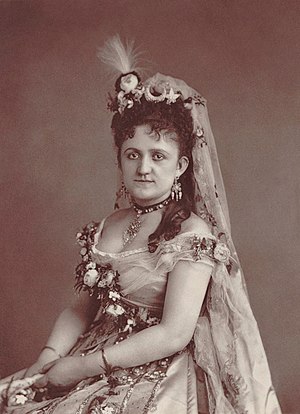
|
Marguerite Priola (1849–1876) was a French operatic soprano. She made her debut in 1869 in Paris as the Messenger of Peace in the first French production of Wagner's Rienzi at the Théâtre Lyrique. She enjoyed a successful career at the Opéra-Comique until 1874, performing mainly coloratura soprano roles. There she created several roles, including Princess Elsbeth in Offenbach's Fantasio, Maritana in Massenet's Don César de Bazan, and Javotte in Le roi l'a dit by Delibes. In 1876, she joined the Opéra de Marseille, where she appeared as Philine in Mignon by Ambroise Thomas. Unable to use her voice to its full potential due to illness, she was booed throughout the performance. The illness developed into a serious outbreak of typhoid fever and she died three weeks later at the age of 27. This 1873 portrait, taken by the French photographer Alexandre Quinet, shows Priola in her role in Le Roi l'a dit. Photograph credit: Alexandre Quinet; restored by Adam Cuerden
Recently featured:
|
September 4

|
The Large Plane Trees, also known as Road Menders at Saint-Rémy, is an oil-on-canvas painting by Vincent van Gogh. Painted in 1889 in Saint-Rémy-de-Provence, France, the painting depicts roadworks underneath autumn trees with yellow leaves. The painting is now in the Cleveland Museum of Art in the U.S. state of Ohio. Van Gogh painted a second version of the scene, titled The Road Menders, which is part of The Phillips Collection in Washington, D.C. Analysis of the paintings has shown that The Large Plane Trees was created first, with The Road Menders being a copy with virtually identical outlines. Painting credit: Vincent van Gogh
Recently featured:
|
September 5
Silver certificates are a type of representative money issued between 1878 and 1964 in the United States as part of its circulation of paper currency. They were produced in response to silver agitation by citizens who were angered by the Coinage Act of 1873, which had effectively placed the United States on a gold standard. Since 1968 they have been redeemable only in Federal Reserve Notes and are thus obsolete, but they remain legal tender at their face value and hence are still an accepted form of currency. This is a complete set of the 1923 series of large-size silver certificates, designed by the Bureau of Engraving and Printing and comprising two denominations, one dollar and five dollars. On the obverse, each banknote bears the portrait of a U.S. president (George Washington and Abraham Lincoln) and the engraved signatures of a register of the Treasury (W. O. Woods and H. V. Speelman) and a treasurer of the United States (H. T. Tate and Frank White). Banknote design credit: Bureau of Engraving and Printing
Recently featured:
|
September 6

|
|
The cheetah (Acinonyx jubatus) is a large cat native to Africa, central Iran and India (where it was reintroduced in 2022 after becoming extinct in the country in the 1950s). The cheetah is the fastest land animal, capable of running at 80 to 98 km/h (50 to 61 mph); as such, it has evolved specialized adaptations for speed, including a light build, long thin legs and a long tail. It typically reaches 67 to 94 cm (26 to 37 in) at the shoulder, and the head-and-body length is between 1.1 and 1.5 m (3 ft 7 in and 4 ft 11 in). Adults weigh between 21 and 72 kg (46 and 159 lb). Its head is small and rounded, with a short snout and black tear-like facial streaks. The coat is typically tawny to creamy white or pale buff and is mostly covered with evenly spaced, solid black spots. Four subspecies are recognised. This photograph, taken in the Okavango Delta in Botswana, shows two young cheetah brothers grooming each other after feeding. Photograph credit: Arturo de Frias Marques
Recently featured:
|
September 7

|
Plasma is one of four fundamental states of matter, characterized by the presence of a significant portion of charged particles in any combination of ions or electrons. It is the most abundant form of ordinary matter in the universe, being mostly associated with stars, including the Sun. Extending to the rarefied intracluster medium and possibly to intergalactic regions, plasma can be artificially generated by heating a neutral gas or subjecting it to a strong electromagnetic field. The presence of charged particles makes plasma electrically conductive, and its response to electromagnetic fields is used in many modern devices and technologies, such as plasma televisions or plasma etching. This photograph shows a plasma ball, a clear glass container filled with a mixture of various noble gases with a high-voltage electrode in the center of the container. When voltage is applied, a plasma is formed within the container. Plasma filaments extend from the inner electrode to the outer glass insulator, giving the appearance of multiple constant beams of colored light. Plasma balls were popular as novelty items in the 1980s. Photograph credit: Colin
Recently featured:
|
September 8

|
The Eurasian nuthatch (Sitta europaea) is a small passerine bird found throughout the Palearctic and in Europe. Like other nuthatches, it is a short-tailed bird with a long bill, blue-gray upperparts and a black eye-stripe. It is a vocal bird with a repeated loud dwip call. There are more than 20 subspecies in three main groups; birds in the west of the range have orange-buff underparts and a white throat, those in Russia have whitish underparts, and those in the east have a similar appearance to European birds, but lack the white throat. Photograph credit: Isiwal
Recently featured:
|
September 9

|
|
Blairmorite is a very rare porphyritic volcanic rock named after the community of Blairmore in southwestern Alberta, Canada. It is characterized by dominant phenocrysts of analcime in a matrix of analcime, sanidine and alkalic pyroxene, with accessory titanite, melanite and nepheline. It is a leucocratic variety of analcimite. Blairmorite is known from only two geological formations worldwide: the Crowsnest Formation in Alberta, where it is associated with agglomerates and tuffs from explosive eruptions, and the Lupata Gorge in Mozambique. This specimen of blairmorite, found in the Crowsnest Formation, is about 17 centimetres (6.7 in) in length. Photograph credit: Paul Glombick; edited by Bammesk
Recently featured:
|
September 10
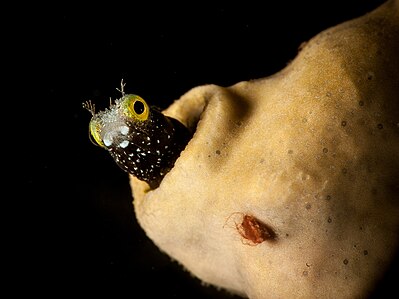
|
The spinyhead blenny (Acanthemblemaria spinosa) is a species of blenny native to the tropical western Atlantic Ocean and Caribbean Sea, with a range extending from the Antilles, the Bahamas, and Florida to Curaçao. It typically inhabits small, rocky reefs surrounded by sand, and is known as a tube blenny from its habit of occupying a hole in a coral or an empty worm tube from which it pokes out its head. The fish has a mottled black, white and red coloration over the entire body, which is rather elongated. As with most blennies, its head has small, hair-like appendages over the eyes, which are large and red. The dorsal fin has 20 to 22 spines and 13 to 16 soft rays. The anal fin has two spines and 21 to 25 soft rays. It grows to a total length of 2.8 cm (1.1 in). Photograph credit: q phia
Recently featured:
|
September 11

|
|
The Tribute in Light is an art installation created in remembrance of the September 11 attacks. It consists of 88 vertical searchlights arranged in two columns of light to represent the Twin Towers. It stands six blocks south of the World Trade Center on top of the Battery Parking Garage. Tribute in Light began as a temporary commemoration of the attacks in early 2002, but it became an annual event, currently produced on September 11 by the Municipal Art Society of New York. The Tribute in Light was conceived by artists John Bennett, Gustavo Bonevardi, Richard Nash Gould, Julian LaVerdiere, and Paul Myoda, and lighting consultant Paul Marantz. Photograph credit: King of Hearts
Recently featured:
|
September 12

|
Andrew George Scott (1842–1880), also known as Captain Moonlite, though also referred to as Alexander Charles Scott and Captain Moonlight, was an Irish-born New Zealand immigrant to the Colony of Victoria, a bushranger there and in the Colony of New South Wales, and an eventual and current-day Australian folk figure. This carte de visite of Scott is believed to have been taken by Charles Nettleton. Photograph credit: Charles Nettleton (attributed); restored by Adam Cuerden
Recently featured:
|
September 13

|
The Oslo I Accord was an attempt to set up a framework that would lead to the resolution of the ongoing Israeli–Palestinian conflict. It was the first face-to-face agreement between the government of Israel and the Palestine Liberation Organization (PLO). It was ratified at a signing ceremony in Washington, D.C., on 13 September 1993, attended by Israeli prime minister Yitzhak Rabin, US president Bill Clinton and PLO leader Yasser Arafat. This photograph shows Arafat, Israeli foreign minister Shimon Peres, and Rabin receiving the 1994 Nobel Peace Prize in Oslo for their participation in the accord. Photograph credit: Saar Yaacov
Recently featured:
|
September 14
|
The Crucifixion and Last Judgement Diptych consists of two small painted panels attributed to the Early Netherlandish artist Jan van Eyck, with areas finished by unidentified followers or members of his workshop. The diptych is one of the early Northern Renaissance oil-on-panel masterpieces, renowned for its unusually complex and highly detailed iconography, and for the technical skill evident in its completion. It was executed in a miniature format; the panels are just 56.5 cm (22.2 in) high by 19.7 cm (7.8 in) wide. The diptych was probably commissioned for private devotion. The left wing depicts the Crucifixion, while the right wing portrays scenes associated with the Last Judgement: a hellscape at its base, the resurrected awaiting judgement in the centre-ground, and a representation of Christ in Majesty flanked by a Great Deësis. The diptych is now in the Metropolitan Museum of Art in New York City, United States. Painting credit: Jan van Eyck (attributed)
Recently featured:
|
September 15

|
|
The white-fronted honeyeater (Purnella albifrons) is a medium-sized bird species endemic to Australia. It is mainly distributed throughout arid and semi-arid landscapes. The white-fronted honeyeater has distinct colourings with a white face, black or brown upper chest with white speckles and yellow panels on their brown wings. Photograph credit: JJ Harrison
Recently featured:
|
September 16

|
|
The Arena of Nîmes is a Roman amphitheatre situated in the French city of Nîmes. Built around 100 CE, shortly after the Colosseum in Rome, it is one of the best-preserved Roman amphitheatres in the world. It is also among the twenty largest Roman amphitheatres of the 400 in existence. It is 133 metres long (145 yd) and 101 metres wide (110 yd), with an arena measuring 68 metres by 38 metres (74 yd by 42 yd). The outer facade is 21 metres high (69 ft) with two stories of 60 arcades. Today, the amphitheatre is the site of two annual bullfights during the Feria de Nîmes, and it is used for other public events such as historical reenactments and concerts. This photograph of the exterior of the amphitheatre was taken in 2019. Photograph credit: Krzysztof Golik; edited by Janke
Recently featured:
|
September 17
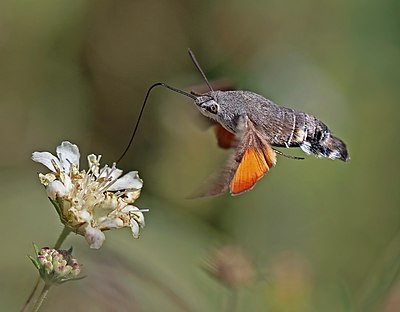
|
The hummingbird hawk-moth (Macroglossum stellatarum) is a species of hawk moth found across temperate regions of Eurasia, from Portugal to Japan. Its long proboscis (25–28 mm; 0.98–1.10 in) and its hovering behavior, accompanied by an audible humming noise, give it a resemblance to the hummingbird. Like hummingbirds, it feeds on flowers which have tube-shaped corollae; this is an example of convergent evolution. The hummingbird hawk-moth flies during the day, especially in bright sunshine, but also at dusk, dawn, and even in the rain, which is unusual for even diurnal hawkmoths. It engages in free hovering flight, which allows more maneuverability and control than fixed-wing flight, despite high energetic cost. This hummingbird hawk-moth in flight was photographed near Yastrebets in Rila, a mountain range in Bulgaria. Photograph credit: Charles J. Sharp
Recently featured:
|
September 18
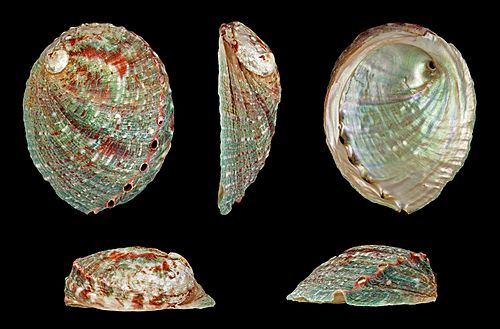
|
|
Haliotis kamtschatkana, also known as the northern abalone or pinto abalone, is a species of large sea snail in the family Haliotidae, the abalones. It is found in kelp beds and in rocky areas in the northeast Pacific Ocean, from Salisbury Sound, Alaska along the coasts of Canada and the United States to Baja California, Mexico. Its distribution also includes Korea. The pinto abalone has an adult shell size of approximately 8 cm (3.1 in) but can occasionally grow as large as 15 cm (5.9 in). The rather thin shell is flattened and ear-shaped. The surface is covered with uneven spiral cords, often almost obsolete, and strongly elevated undulations or lumps. This image shows five views of a H. kamtschatkana shell found in Baja California. Photograph credit: H. Zell
Recently featured:
|
September 19
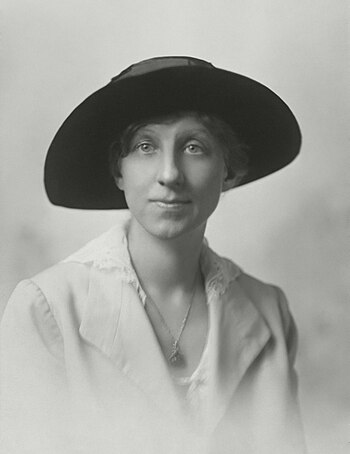
|
Mabel Vernon (September 19, 1883 – September 2, 1975) was an American suffragist, pacifist, and a national leader in the suffrage movement in the United States. A Quaker and a member of the National American Woman Suffrage Association, Vernon was inspired by the methods used by the Women's Social and Political Union in the United Kingdom. She was one of the principal members of the Congressional Union for Woman Suffrage, and helped to organize the Silent Sentinels' protests that involved daily picketing of Woodrow Wilson's White House. This photograph of Vernon was taken around 1917, the year in which she was elected the secretary of the National Woman's Party, and became one of the first six women to be arrested while picketing the White House, under charges of "obstructing the traffic". They were each ordered to pay a $25 fine or spend three days in jail; all of the women insisted they were innocent and refused to pay the fine. Photograph credit: Edmonston; restored by Adam Cuerden
Recently featured:
|
September 20
|
The 1990 Nepalese revolution was a multi-party movement that brought an end to absolute monarchy and the beginning of constitutional monarchy, eliminating the panchayat system in Nepal. The revolution began in February 1990 following an alliance between two opposition groups: the Nepali Congress and the United Left Front. In the subsequent weeks, the movement became increasingly large and dangerous as thousands of students marched against riot police and hundreds were arrested and injured. The movement called for bandhs (a kind of general strike) that quickly spread across the country. In early April, 200,000 people marched to Kathmandu in protest of the monarchy. Over the course of several days, police shot and killed dozens as protesters demanded a restoration of the 1950s-era multiparty democracy system. Protesters surrounded government buildings, and King Birendra eventually removed the ban on political parties on 8 April, ending the revolution. This photograph, taken on 9 April, shows Durga Thapa, a Nepali student, leaping in the air while displaying a double victory sign amidst a large crowd in Asan, Kathmandu. Photograph credit: Min Ratna Bajracharya
Recently featured:
|
September 21

|
Spathiphyllum wallisii, the peace lily, is a species of indoor houseplant in the family Araceae. The genus name means "spathe leaf", and the specific epithet is named after Gustav Wallis, a German plant collector. This photograph depicts an inflorescence of a S. wallisii potted plant in Lysekil, Sweden. The spadix is 2.7 centimetres (1.1 in) in length. Photograph credit: W.carter
Recently featured:
|
September 22

|
The common buzzard (Buteo buteo) is a bird of prey in the family Accipitridae. The species lives in most of Europe and extends its breeding range across much of the Palearctic as far as northwestern China (the Tian Shan), far western Siberia, and northwestern Mongolia. It is a year-round resident over much of its range. However, buzzards from the colder parts of the Northern Hemisphere as well as those that breed in the eastern part of their range typically migrate south for the northern winter, many journeying as far as South Africa. The common buzzard is an opportunistic predator that can take a wide variety of prey, but it feeds mostly on small mammals, especially rodents such as voles. It typically hunts from a perch. Like most accipitrid birds of prey, the common buzzard builds a nest and has a relatively small brood of young. It appears to be the most common diurnal raptor in Europe; estimates of its total global population run well into the millions. This steppe buzzard (of the subspecies B. b. vulpinus) was photographed in Etosha National Park, Namibia. Photograph credit: Charles J. Sharp
Recently featured:
|
September 23

|
Victoria Woodhull (September 23, 1838 – June 9, 1927), was an American leader of the women's suffrage movement. She ran for President of the United States in the 1872 election. An activist for women's rights and labor reforms, Woodhull was also an advocate of "free love", by which she meant the freedom to marry, divorce and bear children without social restriction or government interference. "They cannot roll back the rising tide of reform," she often said. "The world moves." She twice went from rags to riches, her first fortune being made on the road as a magnetic healer before she joined the spiritualist movement in the 1870s. This formal photographic portrait of Woodhull was taken by Mathew Brady around 1870. Photograph credit: Mathew Brady; restored by Adam Cuerden
Recently featured:
|
September 24
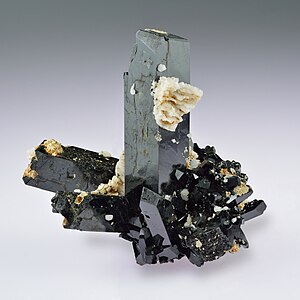
|
Aegirine is a member of the clinopyroxene group of inosilicate minerals. It is the sodium endmember of the aegirine–augite series, and has the chemical formula NaFeSi2O6, in which the iron is present as the ion Fe3+. Aegirine occurs as dark green monoclinic prismatic crystals. This photograph depicts aegirine crystals with minor feldspar found at Mount Malosa in Zomba, Malawi. Photograph credit: Ivar Leidus
Recently featured:
|
September 25

|
The Savonia railway is a five-foot-gauge (1,524 mm) railway in Finland. Beginning at Kouvola, it connects southern Finland with the eastern regions of South Savo and North Savo via the cities of Pieksämäki, Kuopio and Iisalmi. This photograph depicts a lumber train pulled by a VR Class Sr1 electric locomotive crossing a drawbridge north of Kuopio. Photograph credit: David Gubler
Recently featured:
|
September 26

|
Edward Bouchet (1852–1918) was an American physicist and educator. He was the first African American to earn a PhD from an American university, completing his dissertation in physics at Yale University in 1876. Bouchet had become one of the first African Americans to graduate from Yale College in 1874. On the basis of his academic record, he was elected to Phi Beta Kappa, an academic honor society. Unable to find a university-teaching or research-facility position due to racial discrimination, he moved to Philadelphia in 1876 and took a position at the Institute for Colored Youth, where he taught physics and chemistry for the next 26 years. This photograph of Bouchet, from the archives of Yale, is part of a portrait album of students in the class of 1874. Photograph credit: George Kendall Warren; restored by Adam Cuerden
Recently featured:
|
September 27

|
|
Kaohsiung is a city with special municipality status in southern Taiwan. Its origins date back to the early 17th century, when it was a small fishing village under various colonial rulers. It has since evolved into Taiwan's second-largest metropolis. Kaohsiung's urban landscape is characterized by a blend of historical and contemporary landmarks. The city is home to the 85 Sky Tower, one of Taiwan's tallest buildings, the Kaohsiung Confucius Temple, and the Port of Kaohsiung. This photograph, taken at night during the 2022 Taiwan Lantern Festival, shows the Kaohsiung Music Center with the Great Tiger Bridge over the Love River. Photograph credit: Y.-C. Tsai
Recently featured:
|
September 28

|
The Unité d'Habitation of Berlin is a 1958 apartment building located in Berlin, a seminal example of modernist architectural design. Designed by Swiss-French architect Le Corbusier, it embodies the principles of his concept of unité d'habitation, an innovative response to post–World War II urban-housing challenges. The building is distinguished by its functionalism and efficiency. It encompasses 530 modular residential units, distributed across seventeen floors. The exterior façade, seen here in 2021, is characterized by the employment of rough-cast concrete, with colors designed by Le Corbusier together with the painter Fernand Léger. Photograph credit: Matthias Süßen
Recently featured:
|
September 29

|
Giuseppe Arcimboldo (1526–1593) was an Italian Renaissance painter best known for creating imaginative portrait heads made entirely of objects such as fruits, vegetables, flowers, fish and books. Born in Milan, he initially trained as a painter under his father Biagio Arcimboldo before serving as a court painter for the Habsburg monarchs in Vienna and Prague. Arcimboldo's oeuvre was largely forgotten after his death, and many of his works were lost. They were not mentioned in the literature of the 17th and 18th centuries, appearing again only in 1885 when the art critic K. Kasati published the monograph Giuseppe Arcimboldi, Milan Artist, describing his role as a portraitist. This pen-and-watercolour self-portrait by Arcimboldo was created in the 1570s and is now in the National Gallery Prague. Drawing credit: Giuseppe Arcimboldo
Recently featured:
|
September 30

|
|
Ignace-Gaston Pardies (1636–1673) was a French Catholic priest and scientist. His celestial atlas, entitled Globi coelestis in tabulas planas redacti descriptio, comprised six charts of the night sky and was first published in 1674. The atlas uses a gnomonic projection so that the plates make up a cube of the celestial sphere. The constellation figures are drawn from Uranometria, but were carefully reworked and adapted to a broader view of the sky. This is the first plate from a 1693 edition of Pardies's atlas, centred on the north celestial pole and depicting part of the northern sky. An index of constellations is provided in the left and right margins, in Latin and French, respectively. Map credit: Ignace-Gaston Pardies
Recently featured:
|
Picture of the day archives and future dates




